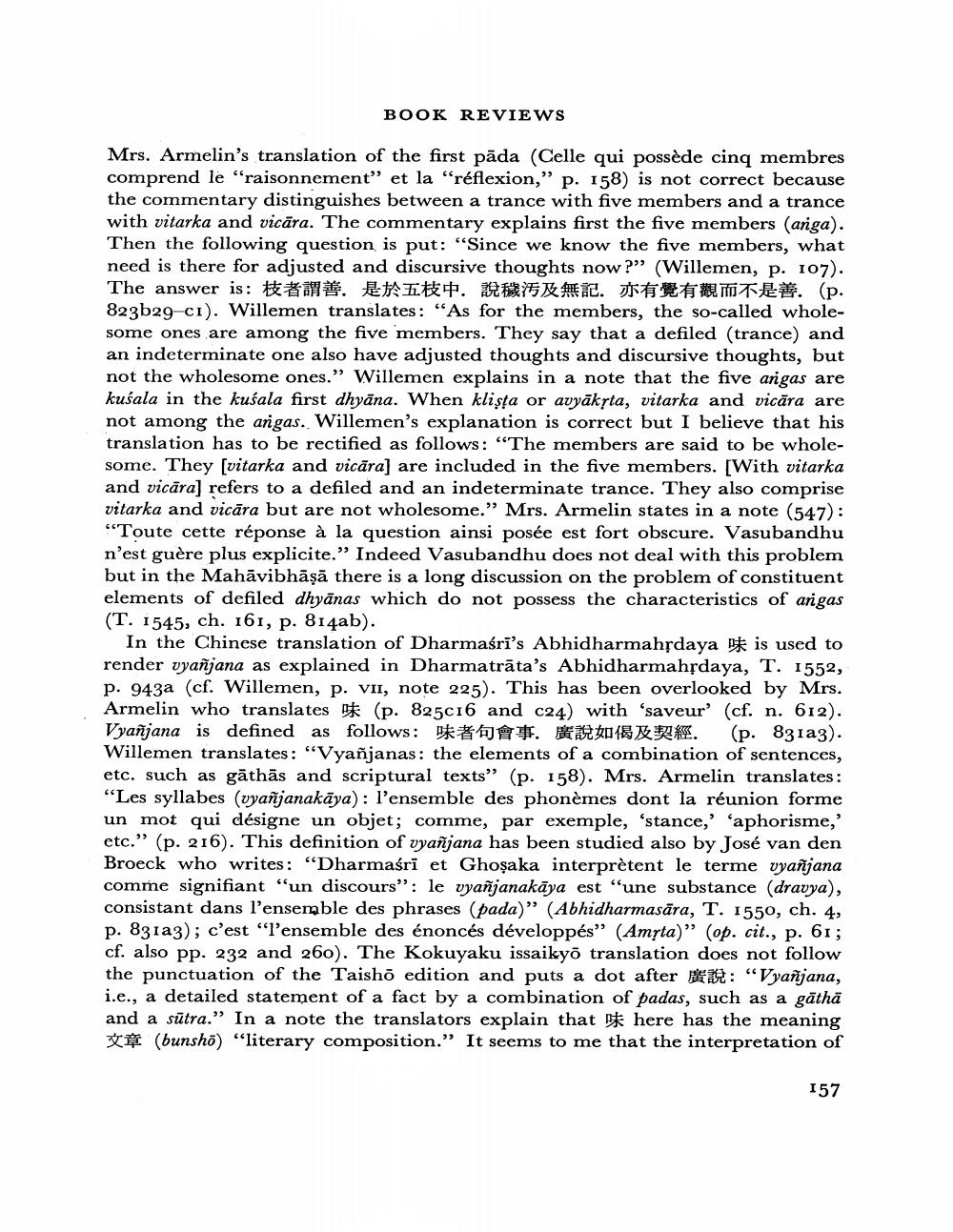Book Title: Book Reviews Author(s): J W De Jong Publisher: J W De Jong View full book textPage 7
________________ BOOK REVIEWS Mrs. Armelin's translation of the first pāda (Celle qui possède cinq membres comprend le "raisonnement" et la "réflexion," p. 158) is not correct because the commentary distinguishes between a trance with five members and a trance with vitarka and vicāra. The commentary explains first the five members (anga). Then the following question is put: "Since we know the five members, what need is there for adjusted and discursive thoughts now?" (Willemen, p. 107). The answer is: # EAE. AT THE AC. F T TEX. (p. 823b29-ci). Willemen translates: "As for the members, the so-called wholesome ones are among the five members. They say that a defiled (trance) and an indeterminate one also have adjusted thoughts and discursive thoughts, but not the wholesome ones.” Willemen explains in a note that the five argas are kusala in the kuśala first dhyāna. When klişta or avyāksta, vitarka and vicāra are not among the argas. Willemen's explanation is correct but I believe that his translation has to be rectified as follows: "The members are said to be wholesome. They [vitarka and vicāra] are included in the five members. [With vitarka and vicāra] refers to a defiled and an indeterminate trance. They also comprise vitarka and vicāra but are not wholesome.” Mrs. Armelin states in a note (547): "Toute cette réponse à la question ainsi posée est fort obscure. Vasubandhu n'est guère plus explicite.” Indeed Vasubandhu does not deal with this problem but in the Mahāvibhāṣā there is a long discussion on the problem of constituent elements of defiled dhyānas which do not possess the characteristics of argas (T. 1545, ch. 161, p. 814ab). In the Chinese translation of Dharmasri's Abhidharmahsdaya Dk is used to render vyañjana as explained in Dharmatrāta's Abhidharmahşdaya, T. 1552, p. 943a (cf. Willemen, p. VII, note 225). This has been overlooked by Mrs. Armelin who translates DF (p. 825016 and c24) with 'saveur' (cf. n. 612). Vyañjana is defined as follows: Dk . 1872. (p. 831a3). Willemen translates: "Vyañjanas: the elements of a combination of sentences, etc. such as gāthās and scriptural texts” (p. 158). Mrs. Armelin translates: “Les syllabes (vyañjanakāya): l'ensemble des phonèmes dont la réunion forme un mot qui désigne un objet; comme, par exemple, 'stance,' 'aphorisme, etc.” (p. 216). This definition of vyañjana has been studied also by José van den Broeck who writes: “Dharmasri et Ghosaka interprètent le terme vyañjana comme signifiant "un discours": le vyañjanakāya est "une substance (dravya), consistant dans l'ensemble des phrases (pada)” (Abhidharmasära, T. 1550, ch. 4, p. 831a3); c'est "l'ensemble des énoncés développés” (Amrta)” (op. cit., p. 61; cf. also pp. 232 and 260). The Kokuyaku issaikyo translation does not follow the punctuation of the Taisho edition and puts a dot after : "Vyañjana, i.e., a detailed statement of a fact by a combination of padas, such as a gāthā and a sūtra.” In a note the translators explain that of here has the meaning (bunsho) "literary composition.” It seems to me that the interpretation of 157Page Navigation
1 ... 5 6 7 8
